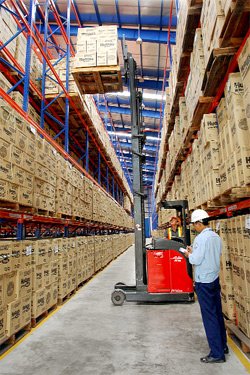VietNamNet Bridge – In Vietnam, the logistics costs make up 25 percent of GDP,
while transport costs account for 50-60 percent of the logistics costs, an
overly high if compared with the average rate in the world.

Businesses still cannot realize the role of logistics
According to Dr Pham Dinh Phuong, a lot of Vietnamese businesses still cannot
take full advantage that logistics can bring. Especially, they have not realized
the important role of logistics in reducing the production costs.
Logistics is the industry that combines marketing, production, stocks, transport
and distribution. Meanwhile, shipping division is a part of the administration
and personnel department, while inventory management belongs to the finance and
accountancy department, and collecting materials is a function of the marketing
or sale department.
In Vietnam, goods have to go through too many intermediate parties which lead to
the higher transaction costs and higher sale prices. In the distribution chain,
the involved parties all try to make profit for themselves. Since they lack
information, they only keep direct contacts with enterprises, while ignoring
other members of the chain, which has resulted in the exaggeration of the
logistics costs.
In Vietnam, the distribution networks are mostly set up in urban areas, while
the networks have not reached out to rural areas. Distributors only undertake
short-distance transport services, while sales agents have to arrange the goods
transport themselves.
While the retail networks are dense in urban areas, big storehouses are mostly
located very far. As a result, the transport costs could be low, but the storage
fees are high, or vice versa, which has also led to the increase of the
logistics costs in general.
Vietnamese businesses now do not have the habit of using outsourcing services,
including customs declaration service, accountancy agents and 3PL services,
while they undertake all the works themselves. Once businesses have to spend
money on too many things, their works cannot be professional.
The logistics industry in Vietnam has been developing strongly, while many
companies now can provide professional services. The higher professionalism
would certainly lead to the logistics cost decreases. However, the problem is
whether businesses can attach much importance to logistics to reduce the
production costs.
Infrastructure still poor
There are 17,000 kilometers of asphalt, more than 3,200 km of railway, 42,000 km
waterways, 266 airports and 20 seaports in Vietnam. However, the quality of the
traffic network is not the same in different places. Though Vietnam has 266
seaports, only 20 can serve the import and export of goods. Most of the seaports
are not capable to receive normal container ships because of the lack of
equipment and experience.
At present, air transport is not yet popular, while road transport remains the
major kind of transport. However, the road system cannot serve the heavy cargo
transport because of the low transport capacity, traffic jam and low technique.
Industrial zones have been completed, but there has been no road linking to the
zones, or the zones are located too far from the seaport systems.
Railway mostly carries passengers, not cargo. With the current sizes of the
rails, it is unsuitable to carry high-tonnage goods. Businesses do not want to
use waterways transport, because it takes much time.
Meanwhile, multimodal transport which allows taking full advantage of the strong
points of different means of transport has yet been popular in Vietnam. This
explains why the retail prices are different in different localities of the
country.
Vietnamese exporters, who try to avoid risks, usually apply the sale prices
based on FOB origin, which does not include the transport costs. Meanwhile, in
order to obtain single prices nationwide, they need to apply FOB destination
prices.
In 2011, the logistics costs in Vietnam reached 25 billion dollars.
Source: Dien dan DN
- © Copyright of Vietnamnet Global.
- Tel: 024 3772 7988 Fax: (024) 37722734
- Email: evnn@vietnamnet.vn